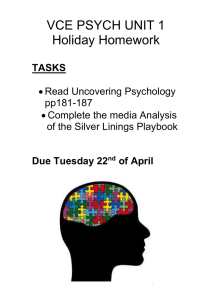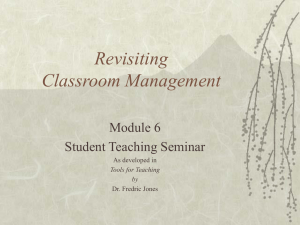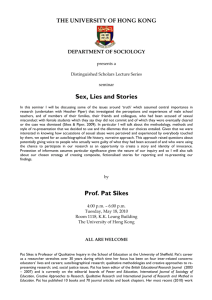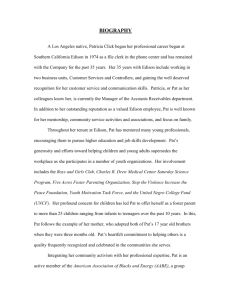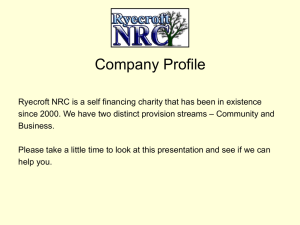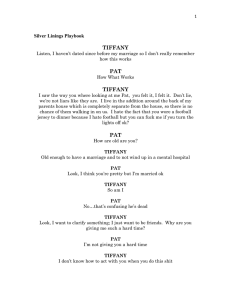Movie discussion resource Silver linings playbook
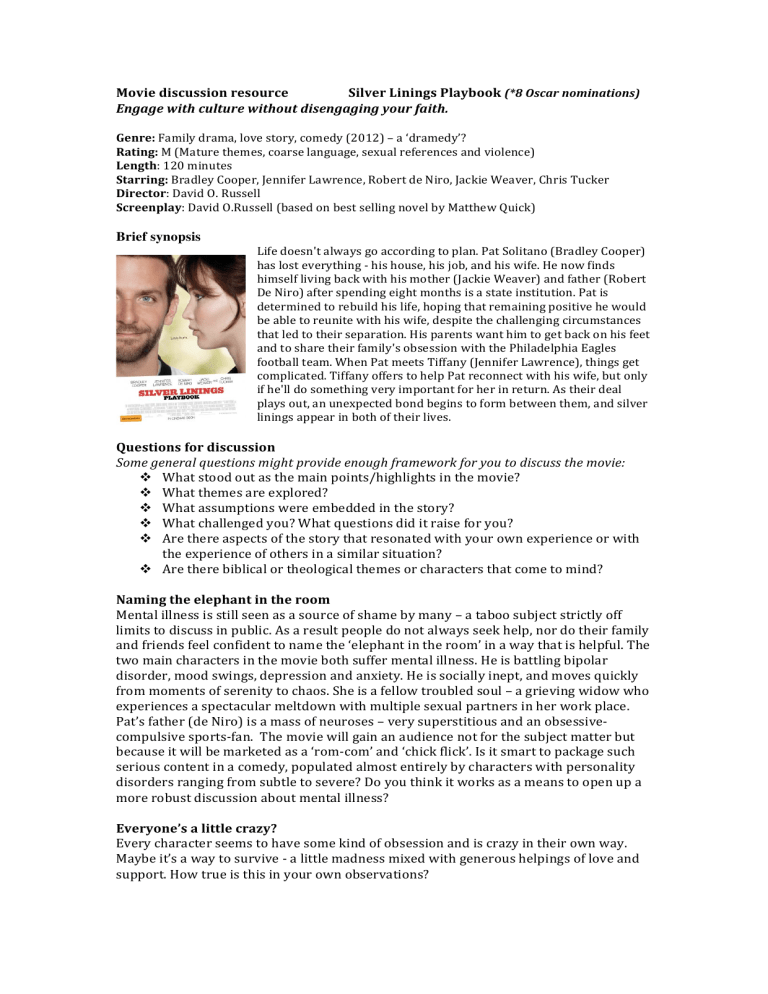
Movie discussion resource Silver Linings Playbook (*8 Oscar nominations)
Engage with culture without disengaging your faith.
Genre: Family drama, love story, comedy (2012) – a ‘dramedy’?
Rating: M (Mature themes, coarse language, sexual references and violence)
Length : 120 minutes
Starring: Bradley Cooper, Jennifer Lawrence, Robert de Niro, Jackie Weaver, Chris Tucker
Director : David O. Russell
Screenplay : David O.Russell (based on best selling novel by Matthew Quick)
Brief synopsis
Life doesn't always go according to plan. Pat Solitano (Bradley Cooper) has lost everything -‐ his house, his job, and his wife. He now finds himself living back with his mother (Jackie Weaver) and father (Robert
De Niro) after spending eight months is a state institution. Pat is determined to rebuild his life, hoping that remaining positive he would be able to reunite with his wife, despite the challenging circumstances that led to their separation. His parents want him to get back on his feet and to share their family's obsession with the Philadelphia Eagles football team. When Pat meets Tiffany (Jennifer Lawrence), things get complicated. Tiffany offers to help Pat reconnect with his wife, but only if he'll do something very important for her in return. As their deal plays out, an unexpected bond begins to form between them, and silver linings appear in both of their lives.
Questions for discussion
Some general questions might provide enough framework for you to discuss the movie:
What stood out as the main points/highlights in the movie?
What themes are explored?
What assumptions were embedded in the story?
What challenged you? What questions did it raise for you?
Are there aspects of the story that resonated with your own experience or with the experience of others in a similar situation?
Are there biblical or theological themes or characters that come to mind?
Naming the elephant in the room
Mental illness is still seen as a source of shame by many – a taboo subject strictly off limits to discuss in public. As a result people do not always seek help, nor do their family and friends feel confident to name the ‘elephant in the room’ in a way that is helpful. The two main characters in the movie both suffer mental illness. He is battling bipolar disorder, mood swings, depression and anxiety. He is socially inept, and moves quickly from moments of serenity to chaos. She is a fellow troubled soul – a grieving widow who experiences a spectacular meltdown with multiple sexual partners in her work place.
Pat’s father (de Niro) is a mass of neuroses – very superstitious and an obsessive-‐ compulsive sports-‐fan. The movie will gain an audience not for the subject matter but because it will be marketed as a ‘rom-‐com’ and ‘chick flick’. Is it smart to package such serious content in a comedy, populated almost entirely by characters with personality disorders ranging from subtle to severe? Do you think it works as a means to open up a more robust discussion about mental illness?
Everyone’s a little crazy?
Every character seems to have some kind of obsession and is crazy in their own way.
Maybe it’s a way to survive -‐ a little madness mixed with generous helpings of love and support. How true is this in your own observations?
Patience in the background
Jackie Weaver’s role as the mother is understated, yet it is she who finds the strength to bring her son home from the mental institution without telling her husband and against doctor’s orders, knowing full well the volatile situation at home. She is the ‘oak’ that hold the family together. Her persistent and attentive presence shows her deep love and care for her family. The mother spends much of her time looking concerned, anticipating yet another out of control situation. The role of carer and supporter can be exasperating, challenging and tiring. What is your experience of this, or that of family and friends?
Told from the heart
The director and Robert de Niro have family members with mental illness (the teenager who knocks on the door is the director’s son). The story is told from the heart, with the hope that it will point to a wider understanding of mental illness. The story does not gloss over the angst and difficulties of bi-‐polar and other mental conditions, nor are they used as cheap humour. It is a serious film in an entertaining package. What is the role of
‘education’ focussed on ‘facts’ in contrast to ‘education’ through entertainment? Can you think of other examples of the latter that have raised consciousness about issues and encouraged people to seek help to address issues and problems? Singer Kylie Minogue’s battle with cancer saw a leap in women seeking mammograms. Might a film on mental illness similarly encourage people to seek help?
The silver lining
Pat seeks the silver lining, trying his best to do it his own way. His mantra is excelsior
('ever upwards' in Latin) and is the lens through which he chooses to view life. For
Tiffany, the dance competition is her way to find the silver lining. In what ways does a change in attitude contribute to a change in experiencing life with all its complexity, and conversely, what examples do you know of an unwillingness to change attitude that
results in ongoing personal hurt and damage in relationships?
The narrative that shapes our lives and view of the world
Pat rants against the author Ernest Hemingway because he’s unhappy that there’s no happy ending. He wants to find the ‘silver lining’ for a better way. What examples can you identify in the biblical narrative that tell a different kind of story -‐ about love and acceptance, being ‘beloved of God’ and the affirmation God has loved us since the moment of conception (Psalm 139). What narratives do you think primarily shapes
people’s view of themselves and the world (media, movies, computer games etc?).
In denial – but who wants to ruffle feathers
Pat seems convinced his marriage will get back on track and things will be normal. He cannot see that his behaviour has long-‐term consequences, and he anticipates things will simply be forgiven. The family doesn’t challenge Pat’s delusion because they don’t want to upset his already fragile mental state. There is collusion in delusion to keep some sort of order. It is Tiffany who plays with the ‘straight bat’, truth telling in ways that are often confrontational but not deliberately hurtful. What are the limitations of truth telling, and the dangers of collusion?
© Rev Sandy Boyce 1 st February, 2013 Pilgrim Uniting Church, www.pilgrim.org.au
This resource is freely available to download and copy but kindly attribute copyright

